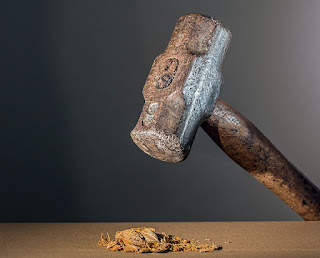 |
| When making tough decisions, Meetings should consider a wide range of tools to support their efforts. |
I am aware, from previous conversations with
various Friends over recent years, that some react with something
approaching horror or scandal at suggestions such as these. On the
other hand, there are also Friends who agree with the idea, having
actually used such approaches successfully, and others who haven't
tried them but as optimistically curious about the possibilities, as
ways of breaking through situations which Quaker processes tend to be
fairly bad at handling. I am sure all three groups will be among
those reading this blog, and please feel free to continue the
conversation in the comments section below, or elsewhere on the
internet.
Quaker decision-making processes, and common
support processes like threshing,
worship sharing, and clearness meetings, are wonderful. They are
powerful, and done faithfully – and sometimes a little creatively –
they can handle a lot more than we sometimes think. They are also
usually quite slow, which is not necessarily a bad thing, and can go
badly awry if those involved do not prepare properly for them, both
in terms of preparation of business, and of individuals preparing
themselves. Specifically Quaker support processes like those
mentioned above can help with that preparation, but they have their
own limitations. Sometimes we have a lot to gain from stepping beyond
our own peculiar ways, and considering what we can take from the
worldly ways of others.
 |
| It's important to choose the right tool for the job. |
It is vitally important to think carefully and
choose the tool or process that is most suitable to your needs. As I
explain the different ways of doing things below, I will also be
explaining some of the situations in which each is most useful. Don't
treat this is some sort of decision-making key, however; the factors
involved are much too complex for that, and I don't go into them in
anywhere near enough detail. If you're unsure, think about how you
would go about applying different methods in your situation, and it
should become reasonably clear what advantages you would see from
each.
Discussion is something we all do, every day. It
is part and parcel of life for the sociable animal that is humanity.
Indeed, it can seem difficult to see it as a process per se.
People involved in preparing business or making decisions on behalf
of a Meeting should always consider informal discussions with
Friends, appropriately chosen, in order to get a broader perspective.
However, there are times when it is appropriate to do it very
deliberately and with a degree of formality. For instance, when
considering significant changes to premises, there are bound to be a
lot of opinions. Simple things like what colour to repaint a room may
not need such an effort, perhaps using straw polls and informal
discussions only. More complex matters like considering the merits of
different access improvements will benefit from the opportunity to
draw on the thoughts – and often unexpected expertise – of more
Friends in a coordinated an interactive way.
Such a meeting
for discussion might at first look like a threshing meeting, but
there are important differences. Threshing might be thought of as
informal compared to a Meeting for Worship for Business, but that is
not the defining difference, and indeed they should not be
particularly informal (see the earlier-linked post for more details
of threshing meetings, or at least my opinions of them). The
principle differences between threshing and Meeting for Worship for
Business are in the purpose – threshing does not seek to make a
decision – and on the degree of spirit-led direction. A discussion
meeting will be more informal, with fewer rules, and not operating
out of silence (though silence to start the meeting and help people
focus and centre is advisable). There should be a facilitator, though
their job is purely to help keep discussion flowing and ensure that
the agenda is covered. If you feel the need for there to be some
rules, the facilitator should make them clear, but the facilitator
should also have discretion to determine what is unhelpful during the
meeting and ask people to stop. Because of this, the facilitator
should have the trust of participants, and should be chosen with that
trust – and being deserving of that trust – in mind.
The result of such
discussion might be a clear consensus or a clear sense of what course
of action is viable and appropriate, but the discussion should not be
the source of that decision. The discussion should be reported on to
the appropriate body, and that body take a decision based on that
report as well as any other factors or information they have
available.
As well as the use of
discussion to involve a wider group in a decision, it can also be
very valuable in small groups, such as committees, more generally.
Not every matter is appropriate to handle in Quaker discernment,
especially not in the early stages. A finance committee preparing a
budget for a meeting or considering revisions to policy will often
benefit from looking at the budget in relatively informal discussion,
much in the style of a secular committee meeting. A premises
committee looking at a range of proposals for alterations or
renovations will benefit from a free exchange of thoughts and ideas,
and may clearly sense from that discussion that they are not ready to
engage in discernment on the subject, deciding – purely from
discussion – that some more information is needed or costings of
other options need to be obtained. It is in the discretion of such a
committee as to when they can make decisions without discernment,
though a good general guideline is regarding the weight of the
decision or its finality. Where a decision will make a significant or
long-term change, or involve spending significant money or
communicating with any outside body on behalf of the Meeting,
discernment will tend to be appropriate; spending a relatively small
amount of money on obtaining appropriate advice to prepare for a
decision will be more suitable for deciding from discussion, provided
that the committee feels that they have clarity on the decision.
There is an
important point, if somewhat formal and technical, when recording
such committee discussions and decisions. A Quaker minute is only
recorded as a result of discernment; even a minute of record should
be recorded in a spirit of discernment and allowing for the Spirit to
lead to its being rejected. As such, the record of such discussions
should not be referred to as a minute; although such records will
often resemble secular minutes, confusion as to the nature of the
record may arise if that term is used in a Quaker context. A
committee I once served on that made considerable use of discussion
recorded such matters as notes,
rather than minutes, and included in them considerable details of the
discussion that led to any particular course of action, much as
well-kept secular committee minutes. Where a minute – in the Quaker
sense – is considered necessary or advisable, for example when
communicating with other Quaker groups (potentially including the
Meeting the committee serves), the committee can enter discernment
following discussion in order to produce a minute. This should not
normally be done to rubber-stamp a matter that has been decided in
discussion; any time you are discerning, there must always be the
possibility of the Spirit not leading you to do what you were
expecting to do. Any minute that is made purely to produce a Quakerly
record of something already determined should be clearly presented as
a minute of record stating that the decision was made, and how –
and any Meeting for Worship for Business receiving such a minute
should understand what this means. This can occasionally be useful in
avoiding double-discernment, as Friends are sometimes uncomfortable
being asked to discern something which another Meeting for Worship
for Business has already discerned. Where that decision is reported
as a minute of record, making clear that the matter was discussed
rather than discerned, the Meeting can feel free that they are not
questioning the validity of another group's discernment (though such
questioning is not always inappropriate, a matter I will return to in
a future post).
Straw polls and surveys
are useful for similar purposes as a meeting for discussion, but have
different strengths and weaknesses. They are not suitable for a
back-and-forth discussion, allowing different views to be aired and
put in front of one another – though they can prepare for such a
task, in which case they can be used ahead of threshing meetings to
allow a free and unstructured submission of thoughts. They are also
very useful for gathering purely factual information, or simple
opinion data, and have the advantage of not requiring those
participating to be in a certain place at a certain time. So, trying
to find out what times and dates are suitable for some event,
surveying dietary requirements for a meal, or preferences about which
show you will go to for an outing are simple cases of facts and
opinions. Opinions that will feed in to a long-term decision, such as
colours for decoration, are less usefully acquired in this way, as
you will get less idea of strength of feeling or reasons for
preferences – which can be very important. Surveys are also very
useful in getting feedback on events, especially if they are
anonymous; people are more willing to be frank in such situations,
and frank feedback is very important. Such information can be very
valuable in future planning and decision-making.
 |
| Consultations can be very powerful tools, but they are also organisationally expensive - in time if not money. |
A Local Meeting is
unlikely to benefit from a formal consultation of this sort, as it is
relatively easy to get most people who are interested in a question
to engage with it in other ways, to come to a threshing or discussion
meeting, or just to be able to participate in the relevant business
meeting. However, across an Area Meeting, a Regional Meeting, General
Meeting, or other wide geographical groups – and national or
non-geographical groups – consultations can be invaluable.
Consultations are a lot
of work, but fundamentally straightforward. You need to clearly frame
what you are trying to achieve, and carefully craft questions or
prompts that will help with that. Put them as concisely and clearly
as possible – with clarity more important than concision. If a
question is becoming complex as you draft it, consider looking for
ways to split the question; it might even be worth asking if you are
framing the question in the right way at all. Questions should be
both direct and open-ended. “We are considering doing X, what do
you think?” is open-ended, but it is not direct. You will get
responses that are woolly, that approach the question in very
different ways, and that are hard to compare and consolidate. Very
occasionally, you might want this, to get an idea of the range of
different responses in all their diversity, but usually it is not
helpful. In the introduction, set out the overriding question, the
problem before you, along with options that are being considered for
dealing with it, and use the questions to lead respondents through
the areas that you anticipate division over. Avoid “push polling”
techniques, where the questions attempt to persuade, rather than
simply eliciting opinions. You want to inform respondents about the
matter, but without prejudicing their opinions. Yes/no questions, or
picking for a list of options without explanation, usually defeat the
object of consultation – but can be useful to get some information
to categorise the responses. For example, were you to be consulting
on changes to the toilets in a Meeting House, it would be appropriate
to ask whether people currently make use of the toilets, or how often
– but this would need to be linked to finding out if there's a
reason for not using them.
There are a
number of options as to how you then allow people to answer the
questions, and using as many as are appropriate (and manageable) is
advisable. For instance, people can respond in writing (either hard
copy or electronically), or you can arrange one-to-one interviews, or
you can arrange discussion meetings where several people all respond
to the questions – and one another – together. Such a discussion
meeting needs an able facilitator, who must be trusted to accurately
report the range of opinions expressed, the degree of disagreement or
consensus, and the strength of feeling exhibited. However, they can
be very valuable in getting views from a group that contains
subunits, especially geographical subunits. For instance, an Area
Meeting (or a committee of such) might run consultation meetings for
each Local Meeting, or a Regional Meeting could run them at either
Area Meeting or Local Meeting level (or differently for each Area
Meeting, where appropriate). The running of such meetings can also be
delegated to the subunits themselves, though care should be taken to
ensure a reasonably consistent manner of running the meetings. If you
have the resources, you might also consider allowing people to
respond be telephone, but for that to be made convenient for those
responding it requires considerable resources – especially as those
take the phone consultation will require a certain degree of skill
and discretion.
Once all consultation
responses, including reports of meetings, are received by those
running the consultation, they must be carefully considered, every
one of them read, and the overall situation and response summarised.
Those running the consultation should always report on it to the
Meeting as a whole, but they will likely want a much fuller report
for their own usage than for sharing with the community in general.
The report for the committee or other group running the consultation
should be frank, clear and not neglect even the smallest minority
opinion; it should, however, reflect due weight of both the frequency
of a given opinion and the weight of the arguments behind them. The
report to the wider Meeting should give a much briefer summary, and
may also report on the committee's response to the consultation as a
whole, and how they propose to go forward – or what decision they
are putting before the Meeting for its own discernment.
When using any of these
methods, it is important to be clear and consistent, from start to
finish, as to the degree of confidentiality of responses. It is not
enough to say that any quotes or summaries of specific cases will be
anonymous, as the details reported might be enough to reveal, at
least to some people, who made the response. Do not assure
participants/respondents of absolute confidentiality unless you are
in a position to provide it. Do make clear to people participating in
group face-to-face exercises what expectations regarding
confidentiality there are. If you are trying to be as confidential as
possible, will the entire committee involved be party to the full
text of all responses to a consultation, or only those Friends
compiling the report? Determine these factors at the start of the
process, as far as is possible, but some answers to surveys or
responses to consultations may cause you to feel the need to increase
the level of confidentiality.
I hope that this has
given a reasonable view of the ways in which techniques that are not
traditional nor specific to Quakers might be useful, without
compromising the integrity of traditional Quaker methods. Rather,
these processes, used appropriately and competently, can provide a
huge support to Quaker decision-making. Do you have experiences, good
or bad, of running or participating in such exercises among Quakers?
Do you disagree with my points, or have any other advice for Friends
considering such methods? As always, comments are most welcome.
~ ~ ~ ~ ~
Did you enjoy this post, or find it interesting, informative or stimulating? Do you want to keep seeing more of these posts? Please consider contributing to my Patreon. More information is available in the post announcing my use of Patreon.
Did you enjoy this post, or find it interesting, informative or stimulating? Do you want to keep seeing more of these posts? Please consider contributing to my Patreon. More information is available in the post announcing my use of Patreon.